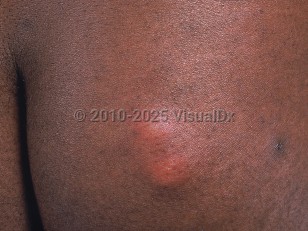Arthropod bite or sting in Adult
See also in: Cellulitis DDx,External and Internal EyeAlerts and Notices
Important News & Links
Synopsis

An arthropod bite or sting may develop a localized inflammatory reaction manifested by localized swelling, redness, pain, burning, and pruritus.
Reactions may be more pronounced in the immunocompromised patient. An exaggerated, sometimes bullous reaction to an arthropod bite is characteristic of certain immunosuppressed states, especially a hematopoietic malignancy or HIV disease. In HIV-infected individuals, arthropod assaults may result in an extremely pruritic skin eruption called "pruritic papular eruption."
Arthropods include insects (stinging or venomous hymenoptera [eg, bees, wasps, fire ants] and non-venomous insects [eg, mosquitos, chiggers, fleas]) as well as ticks, mites, spiders, scabies, and body lice. Other arthropods often remain unidentified.
Arthropods may transmit human illness (including tick bite fever, Lyme disease, Rocky Mountain spotted fever, a variety of encephalitides, malaria). Venomous bites may trigger systemic toxic or allergic reactions, including anaphylaxis. An ascending paralysis caused by a neurotoxin may occur after a tick bite.
Some arthropod infestations, such as pediculosis capitis, scabies and crusted scabies, are highly contagious and pose a particular problem in the institutional setting.
There are highly variable global distributions of insects and arthropods. In returning travelers, insect bites are the fourth most common skin complaint diagnosed.
Reactions may be more pronounced in the immunocompromised patient. An exaggerated, sometimes bullous reaction to an arthropod bite is characteristic of certain immunosuppressed states, especially a hematopoietic malignancy or HIV disease. In HIV-infected individuals, arthropod assaults may result in an extremely pruritic skin eruption called "pruritic papular eruption."
Arthropods include insects (stinging or venomous hymenoptera [eg, bees, wasps, fire ants] and non-venomous insects [eg, mosquitos, chiggers, fleas]) as well as ticks, mites, spiders, scabies, and body lice. Other arthropods often remain unidentified.
Arthropods may transmit human illness (including tick bite fever, Lyme disease, Rocky Mountain spotted fever, a variety of encephalitides, malaria). Venomous bites may trigger systemic toxic or allergic reactions, including anaphylaxis. An ascending paralysis caused by a neurotoxin may occur after a tick bite.
Some arthropod infestations, such as pediculosis capitis, scabies and crusted scabies, are highly contagious and pose a particular problem in the institutional setting.
There are highly variable global distributions of insects and arthropods. In returning travelers, insect bites are the fourth most common skin complaint diagnosed.
Codes
ICD10CM:
T63.481A – Toxic effect of venom of other arthropod, accidental (unintentional), first encounter
SNOMEDCT:
409985002 – Arthropod bite wound
T63.481A – Toxic effect of venom of other arthropod, accidental (unintentional), first encounter
SNOMEDCT:
409985002 – Arthropod bite wound
Look For
Subscription Required
Diagnostic Pearls
Subscription Required
Differential Diagnosis & Pitfalls

To perform a comparison, select diagnoses from the classic differential
Subscription Required
Best Tests
Subscription Required
Management Pearls
Subscription Required
Therapy
Subscription Required
References
Subscription Required
Last Updated:06/14/2018
 Patient Information for Arthropod bite or sting in Adult
Patient Information for Arthropod bite or sting in Adult
Premium Feature
VisualDx Patient Handouts
Available in the Elite package
- Improve treatment compliance
- Reduce after-hours questions
- Increase patient engagement and satisfaction
- Written in clear, easy-to-understand language. No confusing jargon.
- Available in English and Spanish
- Print out or email directly to your patient
Upgrade Today

Arthropod bite or sting in Adult
See also in: Cellulitis DDx,External and Internal Eye
